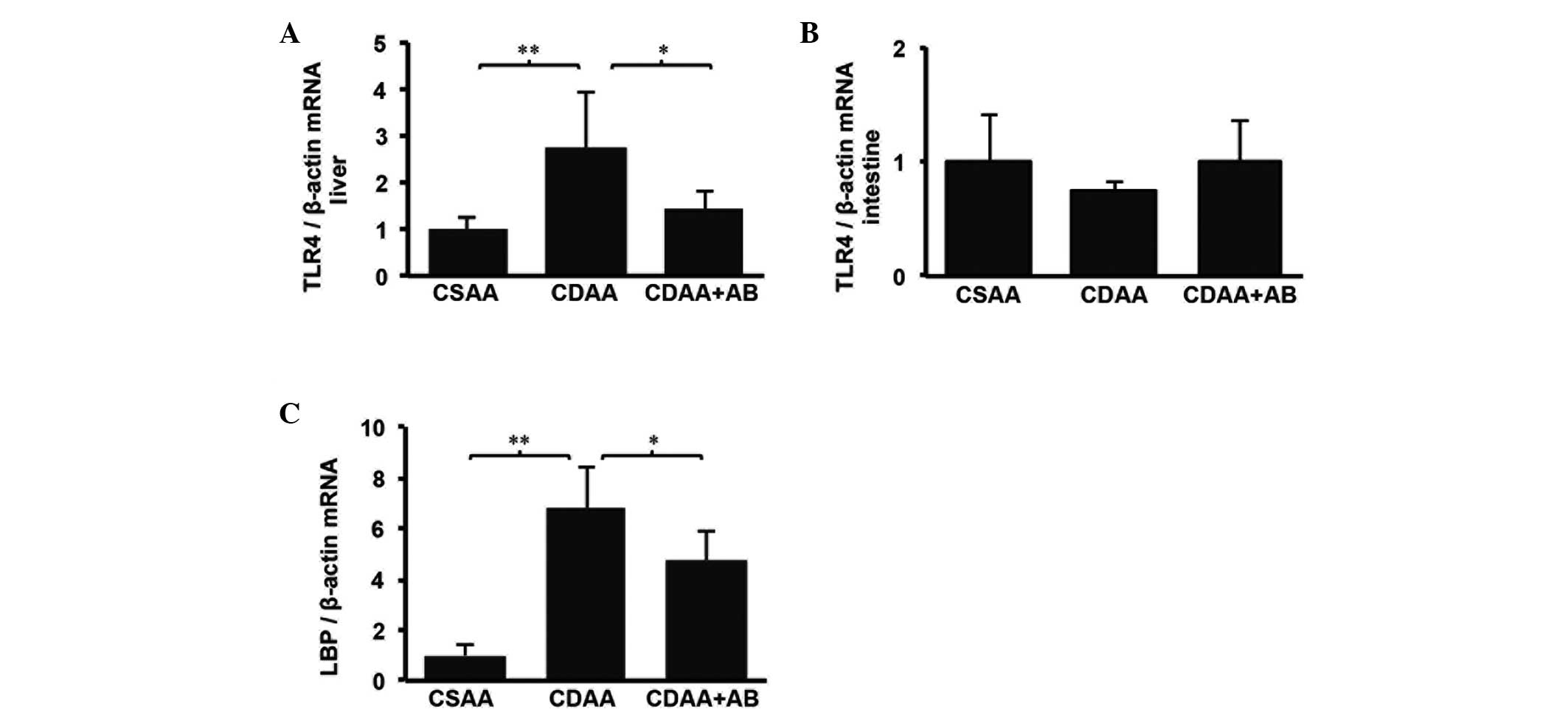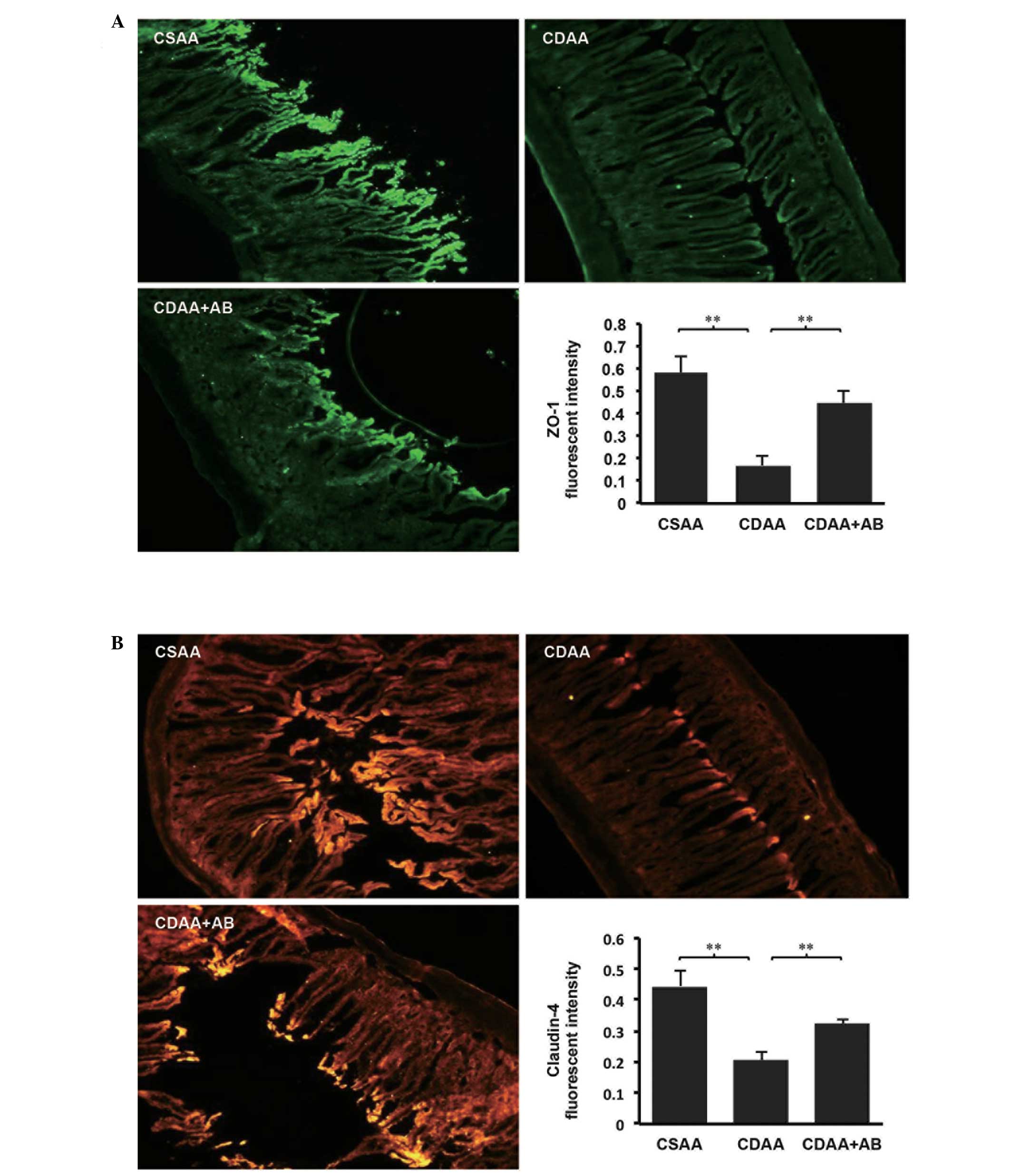|
1
|
Angulo P: Nonalcoholic fatty liver
disease. N Engl J Med. 346:1221–1231. 2002. View Article : Google Scholar : PubMed/NCBI
|
|
2
|
Henao-Mejia J, Elinav E, Jin C, et al:
Inflammasome-mediated dysbiosis regulates progression of NAFLD and
obesity. Nature. 482:179–185. 2012.PubMed/NCBI
|
|
3
|
Ekstedt M, Franzen LE, Mathiesen UL, et
al: Long-term follow-up of patients with NAFLD and elevated liver
enzymes. Hepatology. 44:865–873. 2006. View Article : Google Scholar : PubMed/NCBI
|
|
4
|
El-Serag HB: Hepatocellular carcinoma. N
Engl J Med. 365:1118–1127. 2011. View Article : Google Scholar : PubMed/NCBI
|
|
5
|
Rivera CA, Adegboyega P, van Rooijen N,
Tagalicud A, Allman M and Wallace M: Toll-like receptor-4 signaling
and Kupffer cells play pivotal roles in the pathogenesis of
non-alcoholic steatohepatitis. J Hepatol. 47:571–579. 2007.
View Article : Google Scholar : PubMed/NCBI
|
|
6
|
Akira S and Takeda K: Toll-like receptor
signaling. Nat Rev Immunol. 4:499–511. 2004. View Article : Google Scholar : PubMed/NCBI
|
|
7
|
Jagavelu K, Routray C, Shergill U, O’Hara
SP, Faubion W and Shah VH: Endothelial cell toll-like receptor 4
regulates fibrosis-associated angiogenesis in the liver.
Hepatology. 52:590–601. 2010. View Article : Google Scholar : PubMed/NCBI
|
|
8
|
Seki E, de Minicis S, Osterreicher CH, et
al: TLR4 enhances TGF-beta signaling and hepatic fibrosis. Nat Med.
13:1324–1332. 2007. View
Article : Google Scholar : PubMed/NCBI
|
|
9
|
Endo H, Niioka M, Kobayashi N, Tanaka M
and Watanabe T: Butyrate-producing probiotics reduce nonalcoholic
fatty liver disease progression in rats: New insight into the
probiotics for the gut-liver axis. PLoS One. 8:e633882013.
View Article : Google Scholar : PubMed/NCBI
|
|
10
|
Ruiz AG, Casafont F, Crespo J, et al:
Lipopolysaccharide-binding protein plasma levels and liver
TNF-alpha gene expression in obese patients: Evidence for the
potential role of endotoxin in the pathogenesis of non-alcoholic
steatohepatitis. Obes Surg. 17:1374–1380. 2007. View Article : Google Scholar : PubMed/NCBI
|
|
11
|
Musso G, Gambino R and Cassader M: Gut
microbiota as a regulator of energy homeostasis and ectopic fat
deposition: mechanisms and implications for metabolic disorders.
Curr Opin Lipidol. 21:76–83. 2010. View Article : Google Scholar
|
|
12
|
Szabo G, Bala S, Petrasek J and Gattu A:
Gut-liver axis and sensing microbes. Dig Dis. 28:737–744. 2010.
View Article : Google Scholar : PubMed/NCBI
|
|
13
|
Nguyen AT, Mandard S, Dray C, et al:
Lipopolysacch arides-mediated increase in glucose-stimulated
insulin secretion: involvement of the GLP-1 pathway. Diabetes.
63:471–482. 2014. View Article : Google Scholar
|
|
14
|
Miele L, Valenza V, La Torre G, et al:
Increased intestinal permeability and tight junction alterations in
nonalcoholic fatty liver disease. Hepatology. 49:1877–1887. 2009.
View Article : Google Scholar : PubMed/NCBI
|
|
15
|
Ruberto F, Ianni S, Babetto C, et al:
Polymyxin-B endotoxin removal device: making the point on
mechanisms of action, clinical effectiveness and possible future
applications: review. Infect Disord Drug Targets. 13:128–32. 2013.
View Article : Google Scholar : PubMed/NCBI
|
|
16
|
Yoshiji H, Kuriyama S, Yoshii J, et al:
Angiotensin-II type 1 receptor interaction is a major regulator for
liver fibrosis development in rats. Hepatology. 34:745–750. 2001.
View Article : Google Scholar : PubMed/NCBI
|
|
17
|
Kaji K, Yoshiji H, Ikenaka Y, et al:
Dipeptidyl peptidase-4 inhibitor attenuates hepatic fibrosis via
suppression of activated hepatic stellate cell in rats. J
Gastroenterol. 49:481–491. 2014. View Article : Google Scholar
|
|
18
|
Roh YS and Seki E: Toll-like receptors in
alcoholic liver disease, non-alcoholic steatohepatitis and
carcinogenesis. J Gastroenterol Hepatol. 28:38–42. 2013. View Article : Google Scholar : PubMed/NCBI
|
|
19
|
Schumann RR: Old and new findings on
lipopolysaccharide-binding protein: a soluble pattern-recognition
molecule. Biochem Soc Trans. 39:989–993. 2011. View Article : Google Scholar : PubMed/NCBI
|
|
20
|
Ulluwishewa D, Anderson RC, McNabb WC,
Moughan PJ, Wells JM and Roy NC: Regulation of tight junction
permeability by intestinal bacteria and dietary components. J Nutr.
141:769–776. 2011. View Article : Google Scholar : PubMed/NCBI
|
|
21
|
Seki E and Schnabl B: Role of innate
immunity and the microbiota in liver fibrosis: crosstalk between
the liver and gut. J Physiol. 590:447–458. 2012. View Article : Google Scholar :
|
|
22
|
Guo S, Al-Sadi R, Said HM and Ma TY:
Lipopolysaccharide causes an increase in intestinal tight junction
permeability in vitro and in vivo by inducing enterocyte membrane
expression and localization of TLR-4 and CD14. Am J Pathol.
182:375–387. 2013. View Article : Google Scholar :
|
|
23
|
Brun P, Castagliuolo I, Di Leo V, et al:
Increased intestinal permeability in obese mice: new evidence in
the pathogenesis of nonalcoholic steatohepatitis. Am J Physiol
Gastrointest Liver Physiol. 292:G518–G525. 2007. View Article : Google Scholar
|
|
24
|
Du Plessis J, Vanheel H, Janssen CE, et
al: Activated intestinal macrophages in patients with cirrhosis
release NO and IL-6 that may disrupt intestinal barrier function. J
Hepatol. 58:1125–1132. 2013. View Article : Google Scholar : PubMed/NCBI
|
|
25
|
Assimakopoulos SF, Tsamandas AC,
Tsiaoussis GI, et al: Intestinal mucosal proliferation, apoptosis
and oxidative stress in patients with liver cirrhosis. Ann Hepatol.
12:301–307. 2013.PubMed/NCBI
|
|
26
|
Assimakopoulos SF, Tsamandas AC, Louvros
E, et al: Intestinal epithelial cell proliferation, apoptosis and
expression of tight junction proteins in patients with obstructive
jaundice. Eur J Clin Invest. 41:117–125. 2011. View Article : Google Scholar
|
|
27
|
Finamore A, Massimi M, Conti Devirgiliis L
and Mengheri E: Zinc deficiency induces membrane barrier damage and
increases neutrophil transmigration in Caco-2 cells. J Nutr.
138:1664–1670. 2008.PubMed/NCBI
|
|
28
|
Chiba M, Katayama K, Takeda R, et al:
Diuretics aggravate zinc deficiency in patients with liver
cirrhosis by increasing zinc excretion in urine. Hepatology
Research. 43:365–373. 2013. View Article : Google Scholar
|
|
29
|
Mohammad MK, Zhou Z, Cave M, Barve A and
McClain CJ: Zinc and liver disease. Nutr Clin Pract. 27:8–20. 2012.
View Article : Google Scholar : PubMed/NCBI
|
|
30
|
De Minicis S, Rychlicki C, Agostinelli L,
et al: Dysbiosis contributes to fibrogenesis in the course of
chronic liver injury in mice. Hepatology. 59:1738–1749. 2014.
View Article : Google Scholar
|














